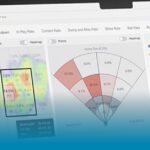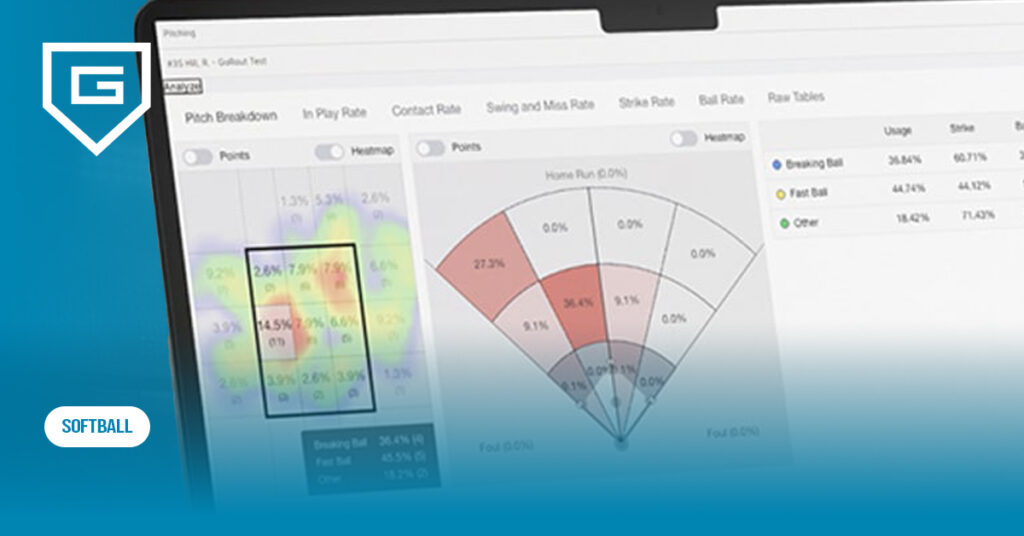15 Football Offensive Schemes for Dynamic and Effective Plays
Reading Time: 10 minutes
Reading Time: 10 minutes
Football offensive schemes are dynamic and effective play strategies to strengthen the offensive strategy.
Wearable technology in sports, like the GoRout football play calling system, revolutionizes coaching and player communication on the field. Using GoRout, coaches can efficiently build, implement and communicate the best football offensive formations, improving their chances of winning games.
In this article, we will provide 15 modern, adaptable schemes to include in your practices and games. We will also explain how to implement GoRout to improve coaching and player performance.
Football Offensive Schemes: Definition and Components
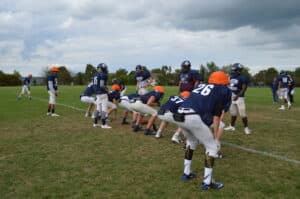
Football offensive schemes consist of formations and play designs that determine player positioning and how they execute offensive plays.
The goal is to gain yardage and exploit the weaknesses of the defense. A well-structured football offensive scheme capitalizes on the vulnerabilities of an opposing defense to advance the ball and create scoring opportunities.
Players align themselves according to their strengths – strong blocking, accurate passing, or quick running. Offensive players dictate the game’s tempo while maintaining possession.
Key elements of football offensive schemes include formations, play designs, and blocking strategies.
15 Football Offensive Schemes to Implement Right Now
Consider implementing these 15 football offensive schemes into your football practice script to elevate your team’s performance and strategy.
Scheme 1: Spread Offense
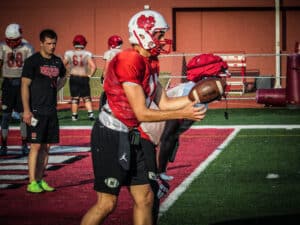
The Spread Offense is recognized for its wide alignment, which spreads the defense horizontally across the field. This football offensive scheme features four or more receivers with a running back in the backfield and the quarterback in the shotgun or pistol formation.
The goal is to create space by stretching the defense and opening up lanes for passing and running games. The spread alignment forces defenders to cover more ground.
Plays using Spread Offense
- Quick Slant: The quarterback takes a snap from the shotgun and quickly throws a short slant route to a receiver.
- Bubble Screen: The quarterback throws a quick pass to a receiver in the slot or outside who is positioned wide.
Scheme 2: West Coast Offense

The West Coast Offense is an offensive scheme emphasizing short, quick passes and precise route running. This football offensive scheme controls the ball and advances it down the field.
The quarterback operates under center or in the shotgun. The offense uses timing and accuracy to complete many short to intermediate passing plays.
Plays using West Coast Offense
- Quick Out Route: The quarterback delivers a fast, accurate pass to a receiver running a quick out route.
- Slant-Flat Combination: One receiver runs a slant route across the field while another runs a flat route toward the sideline.
Scheme 3: Option Offense
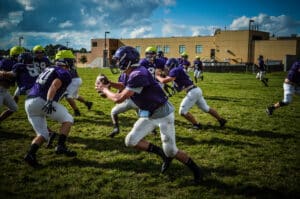
The Option Offense gives the quarterback choices based on the defensive alignment. It confuses the defense and takes advantage of defensive mismatches, with the quarterback making decisions on the fly.
The quarterback can hand off the ball to a running back, keep it and run or make a quick pass. Running backs lined up behind or beside the quarterback create space for different running lanes that the quarterback must read.
Plays using Option Offense
- Triple Option: The quarterback has three options: hand off to the fullback, keep the ball and run or pitch it to the running back on the outside.
- Read Option: The quarterback reads the defensive end’s reaction to decide whether to hand off to the running back or keep the ball and run himself.
Scheme 4: Air Raid Offense

The Air Raid Offense is a high-paced, pass-heavy offensive scheme designed to maximize passing yardage and spread the field. This strategy was developed by Hal Mumme in the 1980s and has been popular ever since.
Formations feature a spread alignment with multiple wide receivers and a single running back or no running back. The quarterback operates in the shotgun and makes quick, precise passes to open-space receivers.
Plays using Air Raid Offense
- Mesh Concept: Two receivers run crossing routes at shallow depths while the quarterback reads the defenders and passes to the open receiver.
- Four Verticals: Four receivers run deep routes straight down the field for one-on-one matchups.
Scheme 5: Power Run Offense
The Power Run Offense is a ground-based offensive play-calling scheme based on a strong running game through physicality and superior blocking.
The balanced run game aligns two tight ends or a fullback and a running back, with the offensive line to dominate the line of scrimmage.
The quarterback is under center, so the offense relies on power runs and straightforward, aggressive blocking to push the ball down the field.
Plays using the Power Run Offense
- Power O: The offensive line pulls one or more linemen to lead-block for the running back who runs off-tackle.
- Iso (Isolation) Play: A fullback leads the running back who runs directly through the gap created by the fullback’s block.
Scheme 6: Pro-Style Offense
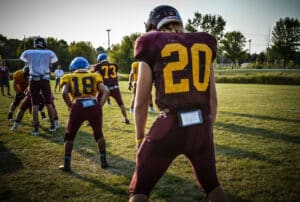
The Pro-Style Offense combines elements of power running and passing games. This formation has a mix of tight ends, fullbacks and multiple wide receivers, with the quarterback playing under center or in the shotgun.
The Pro-Style Offense is adaptable and effective against a variety of defenses. It uses strong offensive line play, a robust running game and a diverse passing attack to keep defenses off balance.
Plays using Pro-Style Offense
- Power Run: The offense uses a fullback and/or tight ends to block for the running back, who runs through the designed gap.
- Play Action Pass: The quarterback fakes a handoff to the running back, drawing the defense toward the line of scrimmage.
Scheme 7: Wing-T Offense
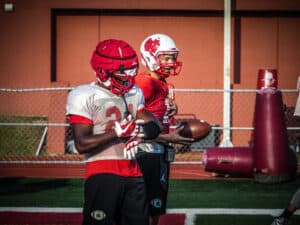
The Wing-T formation emphasizes misdirection, deception and a strong running game. The offensive line is in a tight formation, and the backfield is positioned in a “wing” alignment, with a fullback and halfback.
Plays using Wing-T Offense
- Power Sweep: The offensive line and wingback block to the outside to create a running lane for the running back, who sweeps around the end.
- Trap Play: The offensive line blocks down while a pulling guard or tackle traps a defensive lineman or linebacker.
Scheme 8: Single Wing Offense
The Single Wing formation is one of the classic offensive formations known for its unbalanced formation and emphasis on running plays. The Single Wing formation is unique, where the quarterback lines up behind the center, and multiple backs are positioned in a single-wing position off one side of the line.
This formation forms power and misdirection through its unusual alignment and the mobility of the backfield. It uses a direct snap to the tailback or a direct handoff from the center to initiate plays.
Plays using Single Wing Offense
- Sweep: The tailback receives a direct snap or handoff and runs around the end, with the offensive line and wingbacks blocking to the outside.
- Buck Lateral: The quarterback or tailback laterals the ball to a running back in the opposite direction.
Scheme 9: Wishbone Offense
The Wishbone Offense is a classic offensive scheme renowned for being a strong running attack and allowing versatility. The Wishbone is one of the offensive formations with a distinctive backfield alignment – three running backs in a “wishbone” shape behind the quarterback.
This setup is for running plays to create multiple options for ball handling, pass protection and offensive attack. A fullback is positioned directly behind the quarterback, with two halfbacks flanking the fullback.
Plays using Wishbone Offense
- Power Sweep: Similar to the standard sweep, but with additional blocking support from the fullback or pulling offensive linemen.
- Play Action Pass: The quarterback fakes a handoff to one of the running backs to draw the defense in and create space for deeper passes.
Scheme 10: Flexbone Offense
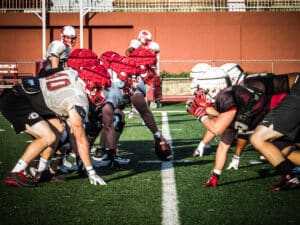
The Flexbone Offense combines Wing-T and Triple Option elements for an unpredictable attack. Three running backs are in a “flex” formation, with the fullback lined up directly behind the quarterback and the two halfbacks offset on either side.
This alignment uses running plays and misdirection to confuse defenses and make big plays.
Plays using Flexbone Offense
- Veer Option: The quarterback reads the defensive end and hands off to the fullback or keeps the ball and runs to the outside.
- Counter Option: The offense fakes a handoff to one side while the quarterback keeps the ball or pitches it to a halfback running in the opposite direction.
Scheme 11: T Formation
The T Formation was one of the highly influential offensive formations in the early 20th century. It consists of three running backs positioned behind the quarterback in a “T” shape. The offensive line spreads across the front, and the quarterback is directly under center.
It is for a strong, balanced attack in the run game and play-action passing. It relies on the offensive line’s control of the line of scrimmage and the backs’ ability to make plays.
Plays using T Formation
- Tackle-Eligible Pass: The quarterback throws a pass to a tackle who has reported as an eligible receiver.
- Dive Play: The running back receives a handoff from the quarterback and runs straight up the middle, with the offensive line blocking down to create a clear path.
Scheme 12: I Formation
The offensive coordinator must have a solid running game for the I Formation. In offensive formations like this, the quarterback is under center, a fullback is directly behind the quarterback, and a tailback is behind the fullback to form an “I” shape.
It creates clear running lanes and makes the secondary vulnerable to play-action passing plays. This formation is used to dominate the line of scrimmage.
Plays using I Formation
- Power Run: The offensive line and fullback block straight ahead while the tailback takes a handoff and hits the gap.
- Iso (Isolation) Play: The fullback leads the way for the tailback, who runs through a specific gap.
Scheme 13: Pistol Offense
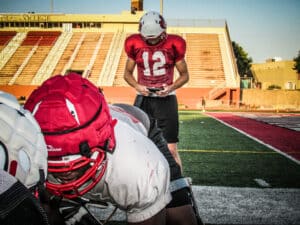
The Pistol Offense is a modern combination of the traditional I Formation and the Shotgun Formation. The quarterback is a few yards behind the center, but the running back is positioned directly behind the quarterback.
It gives the quarterback a clear view of the defense for a strong running game.
Plays using Pistol Offense
- Inside Zone Run: The running back receives a handoff from the quarterback and runs through the middle of the offensive line.
- Outside Zone Run: The quarterback hands off to the running back, who runs towards the outside edge of the defense while the offensive line blocks in a zone scheme.
Scheme 14: Run and Shoot Offense
The Run-and-shoot Offense uses the passing game and spread formations. This offense is a spread-out alignment with multiple wide receivers and less focus on tight ends.
A head coach creates multiple man-coverage opportunities by spreading pass catchers out wide.
Plays using Run and Shoot Offense
- Four Verticals: The quarterback drops back and throws deep passes to four receivers running vertical routes downfield.
- Slant and Go: A receiver runs a quick slant route and then accelerates into a deep route.
Scheme 15: Erhardt-Perkins Offense
The Erhardt-Perkins Offense was popularized by Bill Belichick, head coach of the New England Patriots. It uses a flexible, no-huddle approach that adjusts to defensive alignments with pre-snap motion, multiple receiver sets and strategic play-calling.
The offense aims to exploit defensive line weaknesses, control tempo, and create opportunities to gain chunk-yardage through the air and to employ a strategic running game.
Plays using Erhardt-Perkins Offense
- Mesh Concept: Receivers run crossing routes to create natural picks and confusion in the defense’s coverage.
- Levels Concept: Receivers run routes at different depths, creating a layered effect that can overwhelm the defense.
Customizing Your Football Offensive Schemes
Customize your football offensive schemes to your team’s unique strengths and weaknesses, integrate football conditioning drills and design a successful football practice plan.
Assessing your team’s strengths and weaknesses
Understanding your team’s capabilities and areas for improvement is the first step. Evaluate each player’s skills, athleticism and position-specific strengths to determine the most effective schemes. Research how to coach football offensive formations and take advice from other coaches.
Adapting schemes to fit player abilities
Your playbook should highlight the strengths of your athletes. Consider your players’ physical attributes and skill sets when designing plays and formations to make for a strong performance on the field.
Countering opponent strategies
Analyze trends in sports to identify common defensive tactics and adjust your offensive schemes accordingly. Implement counterplays and adjustments to exploit defensive players’ weaknesses and neutralize their strengths.
Continuous improvement and flexibility
Successful offensive schemes require ongoing refinement and flexibility. Review and adjust your football practice plan to add new disciplines and strategies. Encourage continuous feedback and analysis to identify areas for improvement and adapt your scheme as needed.
Implementing GoRout into Football Practice and Games
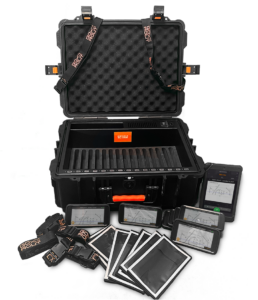
Effective communication helps college football teams and coaches improve performance and control during games and practices. Clear communication allows the head coach to avoid errors and build confidence among teammates. Communication systems minimize confusion and maximize reps.
The GoRout coach-to-player communication system is a reliable solution that optimizes football practices and games, optimizing team communication efforts.
This advanced sports coaching technology helps teams achieve an average of 2.5 reps per minute, giving coaches more time to teach and players more opportunities to develop their skills.
GoRout equipment prepares college football teams, youth players, and high school football teams for game day.
Get a quote today.
Web scripting app
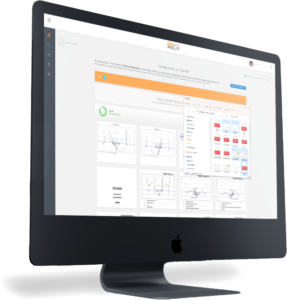
The GoRout Scripting App streamlines practice planning by integrating seamlessly with your existing card drawing software. It allows you to easily add, edit, copy, and organize practice scripts.
Say goodbye to football coaches play cards and messy spreadsheets.
Use the app to copy, move and flip plays between periods. It’s also compatible with Google Chrome so that you can access your practice plans from any device.
On-field practice app

The GoRout on-field practice app provides fast and easy communication with each player. Key features of the app include real-time formation changes with a simple tap and flagging plays for review.
The app also supports live card editing, allowing coaches to start, end, and organize practices. Use the app to instantly send plays directly to players’ devices.
Player devices

As a leader in wearable technology for sports, the GoRout football practice device enables coaches to communicate effectively with their teams. These devices are simple to use, requiring no setup or Wi-Fi connection. Teams only need to select their practice group on each unit and be ready to receive plays. The devices vibrate to alert players when a new play is sent so everyone stays synchronized and prepared.
Here’s how you can integrate GoRout into your practice:
- Walkthroughs
- 7-on-7 football
- Special teams
- Preparation against up-tempo teams
Check out these GoRout testimonials written by hundreds of coaches who trust the GoRout system to up their game and help them win.
Get a quote for the first step towards a better football practice experience.
Final Words About Football Offensive Schemes
These 15 football offensive formations will help coaches improve their strategies and create a diverse playbook this season.
GoRout football coaching gear enhances performance through well-designed offensive schemes. Use GoRout to streamline communication, adapt to various game situations and maximize your team’s potential to win.
Get a quote today.



